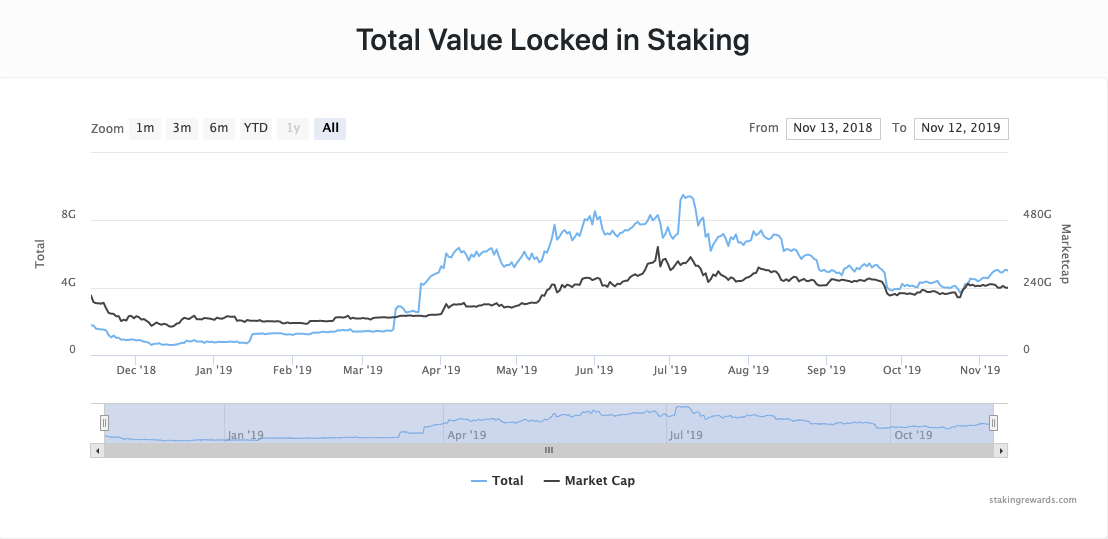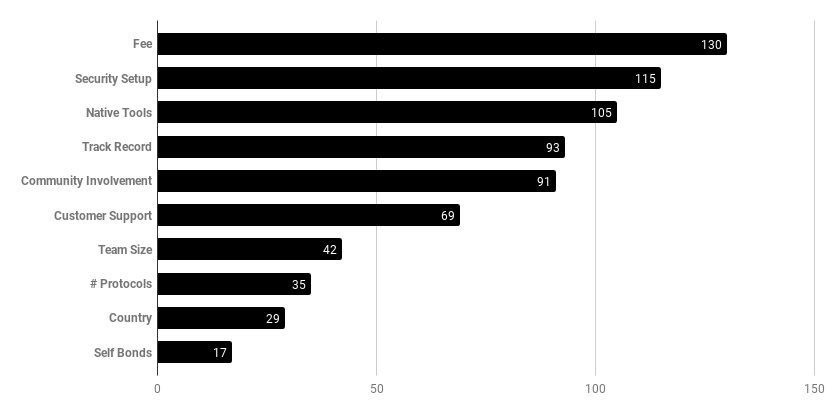All blockchain networks have one thing in common: transactions need to be verified. For example, bitcoin adopts Proof of Work (PoW), the so-called mining, which requires a lot of electricity. Proof of Stake(PoS) is another kind of consensus mechanism, which has different evolution and integration forms. We call it staking.
The token staking, which allows the token holders to gain some decision-making power on the blockchain network and vote to earn profits. This is very similar to the fact that people get interest by depositing money in a bank account which enables the bank to make profits with the deposit.
One of the main advantages of token staking is that it no longer demands constant purchases of expensive hardware and electricity consumption. Unlike the PoW blockchain network (to obtain low probability rewards by random process), the PoS system provides guaranteed returns and predictable sources of income.
Prediction of Industry Development

The value of funds staking depends on two main factors: the underlying asset price and the staking ratio.
Next year, Ethereum will bring about US$30 billion of liquidity to the existing US$20 billion of market assets. In addition, other markets such as Polkadot and Dfinity (whose market values are nearly US$1 billion) will also bring more liquidity.
Considering the current prices and 40% of average staking rate for all the assets, the total value of staking assets within one year will reach US$19 billion (an increase of 271%).

The next few years may be an important period for decentralized finance (DeFi), especially once many real assets are deployed on the blockchain, the decentralized or open finance will surely usher in a round of rapid development.
If the decentralized finance allows a lot of assets to smoothly transit to the blockchain for open and transparent contract transactions in the market, then it will inevitably ensure the assets security and transparency between the investors and borrowers, which may solve the problem of financial non-transparency.
Julian Buttrup of Stake Capital said: “Decentralized finance will not replace traditional finance, but it provides another solution for people. The open Internet needs open finance. At present, there are many projects in the decentralized finance sector that are in the development stage. It is expected that the funds targeted for decentralized financial projects will reach about US$2 billion in the coming year.
Although the prospects for the pledge ecology are encouraging, its further development still faces many challenges.
Main Challenge

In addition to the lock-in time of staking and the final introduction of penalty measures, user education on staking-related responsibilities and risks remains a huge challenge. Unlike the PoW, PoS is a more specific and intuitive way that everyone can participate directly or indirectly, but many users are not aware of this measure.
Of course, the user experience is also a challenge. Using the public and private keys every day is not what the user wants to do. Creating a non-technical experience of joining a staking will greatly enhance the user experience with staking services.
A healthy user community is also essential. The cryptocurrency community is usually driven by emotions, but it is important that the community focus on the users and enable them to understand the developments, educate them to maintain a healthy ecosystem and community. Communities should provide users with sustainable value propositions, demonstrate the research, development, preventions and disclosure of fraud.
At the same time, staking is still a very niche market without any regulatory measures. Communities, staking service providers and regulators need to solve the problems such as relationships between staking service providers and anonymous consignors, tax treatment, disclosure, customer protection and user funds custody.
The general feasibility of PoS has not been confirmed. People may be skeptical until they see evidence of surviving from the Black Swan incidents, such as the attacks or multiple verifier failures. In addition, the cryptocurrency staking demands to sign with private keys with many tokens, which results in big risk of funds exposure.
The security of network depends on the quality of the staking service operations. Considering the deep understanding and active involvement of the protocol, the service providers must skillfully allocate their resources because they cannot operate all the protocols.

Another big challenge is the wider adoption of staking mechanisms in practical applications. Many blockchain networks based on POS adopt the inflation as the primary incentive mechanism. For the users without staking, it means that their share of system will be diluted with the creation of new tokens. In order to overcome this problem, the rewards need to be obtained from transaction costs. By widespread application, the protocols can reduce inflation. Increasing the practicality (the list of trading platforms with mobile trading pairs), motivating the use of blockchain networks and creating a simple experience may be the way to increase the rate of application.
In terms of protocol design, in order to find the right balance between security and economic incentives, we must collect more empirical data from the cases in the real world. We may or may not find the “best” version POS. The on-chain governance is a fair form of consensus formation, but it’s still possible to consider some centralization elements in critical times to take quick actions and solve problems.
Many protocols have enough technical ability to support decentralized verifiers. However, due to the initial allocation of tokens and the limited degree of decentralization, we’re indeed facing the enormous challenge of transforming from the early users of staking token to the universal token holders. It’s also a challenge to find good incentives without sacrificing the decentralization.
In some protocols, the staking ratio needs to be maintained, which means you need to constantly add and bind tokens by yourself. You can choose to purchase the tokens as usual (which will cost a lot of money in some time), or invite someone to fund this self-binding in exchange for higher returns. Although the staking and authorization are not regulated in most cases, it can bring additional risks and processes for the verifier and its customers in this case.
One of the biggest challenges for the POS and staking is the sustainability. Operating the verifier nodes requires various operational costs, including the costs of servers and infrastructure, working staff, rent and so on, depending on the certifier’s settings. In most cases, these fees are paid after converting the staking awards into legal currencies. For this reason, the blockchain with the POS may cause great difficulties for the node operator when the price fluctuation of tokens is generated within the protocols.
The last issue is the standardization. Each of the POS tokens almost adopts different technical means, so there’s the lack of standardization. The fragmentation due to lack of interoperability is one of the main challenges for the staking.
How do users choose the staking service provider?

Obviously, for the most users, the charge is the most important factor for them to decide on some staking service provider. By means of security settings, tools and community involvement, we have seen that providers are correctly solving the issues at the demand level.

The users seem to be less concerned about the size of team, the number of supporting protocols, the countries in which the team operates or the amount of funds the service provider controls. In terms of the costs, the providers still have a lot of potential to educate the users that the fees should not be predatory, otherwise they will lose attention to some important aspects and everyone will suffer from great losses.
The impact of large companies accessing to the market

Be alert to big sharks.
All major participants will provide some form of staking service in 2019. Small-scale service providers must take quick actions to compete with the comprehensive products of large companies. Meanwhile, specific value propositions and innovations are needed to be distinguished from the services of major companies.
Need to balance the advantages and disadvantages of the exchange
Most people believe that trading platforms, custodians and wallets will dominate the staking market because they naturally own the capital advantage of attracting many users with assets. The staking services may not be extremely attractive to trading platforms because their primary income comes from transaction fees. The staking costs of custodian are usually very high with many risks.
In addition, users should also make trade-offs when using the trading platform for staking. Firstly, they need to trust the trading platform. If they store tokens there, even if most tokens are pledged from the cold wallet, some are still available for immediate sale. Not everyone is willing to take on such risks, especially when they own many tokens.
As a differentiated niche market
Small companies are advantageous because they can focus on certain chain ecosystems, such as one or two chains instead of the integration model. They may be able to participate in certain ecosystems deeply, which may result in differentiated rivalry.
When smaller suppliers find niche markets to provide localized customer service, develop tools for ecosystems and conduct strategic operation in the areas where larger participants find it too small or specific, both the small suppliers and large suppliers can develop together.
New way of operations
The minor staking service providers can adopt new methods for staking by means of development tools, smart contracts or contribution to core protocols. For example, Cryptium Labs is making some changes to the core protocols, which will enable programmable staking and allow suppliers of any sizes to write smart contracts to implement different policies or terms of service.
Small companies will have the chance to become pure participants, so they can take the lead in educating the community, participating in governance and ensuring the updating of the infrastructure. If the protocols are too concentrated, the community can build better incentives for decentralization. For the sake of further development of staking service ecosystem, we still need to raise awareness of the staking services.
Availability
Many of the on-chain operations are very complicated and the users are usually doubtful about the security systems, including the convenience. We need to focus on the final users who can make use of the network without any technical knowledge. Ideally, people will not realize that they are interacting with the blockchain.
Solutions for Secure Trusteeship
Benefits should take precedence over the fear of hackers and technical barriers. Therefore, the secure regulatory infrastructure, the robust blockchain protocols and the platforms allowing staking are very critical. The trading platforms and lending platforms will play a vital role in motivating the customers into the pledgers.
Compliance
It is also important to clarify the compliance. It may release huge amounts of money from institutional investors and pension funds. The total market value of staking is still too small now and it may still be easily manipulated.
Dilution of non-pledgers
Since holding the staking tokens without pledge will incur huge costs (as the tax on not protecting the blockchain network), every investor and enterprise should be familiar with the concept of staking. Therefore, the products and services based on it will inevitably become the main topic in the coming years.
Pioneer
Knowledgeable institutional investors and funds will play an important role in large-scale application. As these funds will seek to diversify their portfolios in the encryption market, more and more people will get involved in.
Education
We can educate the users to be aware that the staking is a profitable opportunity and participation will have a greater contribution to the ecosystem. They should be well aware of the quality of each verifier in multiple areas as well as the current issues and governance on the network.
Countermeasures for Economic Collapse
We have already realized that people need a valuable storage. The weak monetary policy has resulted in hyperinflation in several countries. If the encryption world can pull through the difficult economies or international financial crisis, then the perception on new governance models —- the staking, the decentralized economy and the internal value of encryption —- will also be greatly improved.

